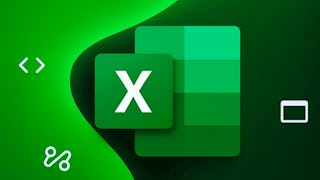"Excel/VBA for Creative Problem Solving, Part 1" is aimed at learners who are seeking to augment, expand, optimize, and increase the efficiency of their Excel spreadsheet skills by tapping into the powerful programming, automation, and customization capabilities available with Visual Basic for Applications (VBA).

Gain next-level skills with Coursera Plus for $199 (regularly $399). Save now.

Excel/VBA for Creative Problem Solving, Part 1
This course is part of Excel/VBA for Creative Problem Solving Specialization

Instructor: Charlie Nuttelman
168,340 already enrolled
Included with
(4,300 reviews)
What you'll learn
Utilize VBA to define and implement custom user-defined functions
Create macros to automate procedures in Excel
Identify the basic programming structures in VBA
Automate Excel’s Goal Seek and Solver tools and use numerical techniques to create “live solutions” to solve targeting and optimization problems
Skills you'll gain
Details to know

Add to your LinkedIn profile
13 assignments
See how employees at top companies are mastering in-demand skills

Build your subject-matter expertise
- Learn new concepts from industry experts
- Gain a foundational understanding of a subject or tool
- Develop job-relevant skills with hands-on projects
- Earn a shareable career certificate

There are 6 modules in this course
Week 1 will introduce you to visual basic for applications (VBA) and teach you the foundational tools required to create basic procedures in VBA. You'll learn about different data types and the scope of variables, how to troubleshoot your code when it's not working, and how to record basic macros using both absolute and relative referencing modes.
What's included
14 videos13 readings3 assignments3 discussion prompts
In Week 2, you will learn how to write proper VBA syntax and basic mathematical expressions; you will learn about objects, properties, methods, and events; and you will learn how to borrow common Excel functions using VBA code. In addition, you will learn how to move information to and from Excel and the Visual Basic Editor (VBE).
What's included
11 videos2 readings2 assignments2 discussion prompts
In Week 3, you will learn how to create your own user-defined functions. You will also learn how to call other subroutines and functions that reside in other files and you will learn how to design subroutines based on a modular approach. Finally, ,you will learn basic error handling in VBA.
What's included
9 videos3 readings2 assignments2 discussion prompts
Week 4 begins the "meat" of programming in VBA, and we are finally moving into some exciting problem solving. You will learn about the common programming structures in VBA (sequence, selection, and repetition) that form the foundation for advanced programming procedures. Several examples will highlight the utility of these programming structures.
What's included
15 videos2 readings2 assignments2 discussion prompts
One of the most valuable uses of VBA is to manage large data sets in Excel. In this module, you'll learn how to automate the processes of filtering, sorting, and removing duplicates. You'll learn additional strategies for cleaning up data. The strategies learned in this week will make you a valued VBA user.
What's included
10 videos2 readings2 assignments2 discussion prompts
The final module of this course focuses on using the R1C1 style of cell formatting. This style, in contrast to the default A1 style of referencing in Excel, makes it much easier and straightforward to perform advanced manipulations to Excel worksheets. Several examples demonstrate the utility of the R1C1 style.
What's included
8 videos1 reading2 assignments1 discussion prompt
Earn a career certificate
Add this credential to your LinkedIn profile, resume, or CV. Share it on social media and in your performance review.
Instructor

Offered by
Explore more from Algorithms
 Status: Free Trial
Status: Free TrialUniversity of Colorado Boulder
 Status: Free Trial
Status: Free TrialUniversity of Colorado Boulder
 Status: Free Trial
Status: Free TrialUniversity of Colorado Boulder
Why people choose Coursera for their career




Learner reviews
4,300 reviews
- 5 stars
87.15%
- 4 stars
10%
- 3 stars
1.34%
- 2 stars
0.34%
- 1 star
1.13%
Showing 3 of 4300
Reviewed on Dec 30, 2020
I'm gonna start my career and I found this course as a nice and clever way to learn vba. I highly recommend to do week five that is as optional. This is an excellent work, see you in part 2.
Reviewed on Aug 1, 2018
Relatively easy, I cleared 3 weeks within 2 hours, and completed the whole module in less than 3 days. I did not spend more than 5 hours each of the 3 days. The honors exercise was interesting.
Reviewed on Mar 14, 2021
Well done, thank you. I had a very limited understanding of loops in programming. After this class, I feel much more comfortable with understanding and designing effective loops and more.
Frequently asked questions
To access the course materials, assignments and to earn a Certificate, you will need to purchase the Certificate experience when you enroll in a course. You can try a Free Trial instead, or apply for Financial Aid. The course may offer 'Full Course, No Certificate' instead. This option lets you see all course materials, submit required assessments, and get a final grade. This also means that you will not be able to purchase a Certificate experience.
When you enroll in the course, you get access to all of the courses in the Specialization, and you earn a certificate when you complete the work. Your electronic Certificate will be added to your Accomplishments page - from there, you can print your Certificate or add it to your LinkedIn profile.
Yes. In select learning programs, you can apply for financial aid or a scholarship if you can’t afford the enrollment fee. If fin aid or scholarship is available for your learning program selection, you’ll find a link to apply on the description page.
More questions
Financial aid available,






